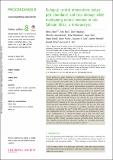| dc.description.abstract | Insect pests are a major challenge to smallholder crop production in sub-Saharan Africa (SSA), where access to synthetic pesticides, which are linked to environmental and health risks, is often limited. Biological control interventions could offer a sustainable solution, yet an understanding of their effectiveness is lacking. We used a meta-analysis approach to investigate the effectiveness of commonly used biocontrol interventions and botanical pesticides on pest abundance (PA), crop damage (CD), crop yield (Y) and natural enemy abundance (NEA) when compared with controls with no biocontrol and with synthetic pesticides. We also evaluated whether the magnitude of biocontrol effectiveness was affected by type of biocontrol intervention, crop type, pest taxon, farm type and landscape configuration. Overall, from 99 studies on 31 crops, we found that compared to no biocontrol, biocontrol interventions reduced PA by 63%, CD by over 50% and increased Y by over 60%. Compared to synthetic pesticides, biocontrol resulted in comparable PA and Y, while NEA was 43% greater. Our results also highlighted that the potential for biocontrol to be modulated by landscape configuration is a critical knowledge gap in SSA. We show that biocontrol represents an effective tool for smallholder farmers, which can maintain yields without associated negative pesticide effects. Furthermore, the evidence presented here advocates strongly for including biocontrol practices in national and regional agricultural policies. | en_US |

